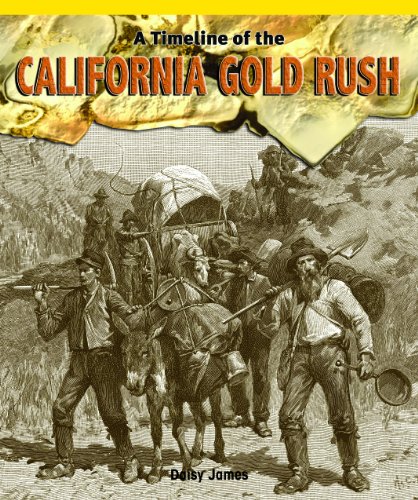-
A Timeline of the California Gold Rush
Kerri O'Donnell
Paperback (Rosen Classroom, Jan. 1, 2009)Strike it rich with this book about the California gold rush and its influence on westward expansion in the United States! The story begins with James Marshalls initial discovery in 1848 and continues with the ensuing migration and lasting affects of the historic era. W
W
-
The Architecture of Frank Lloyd Wright: Understanding the Concepts of Parallel and Perpendicular
Janey Levy
Paperback (Rosen Classroom, Jan. 1, 2005)Describes the work of Frank Lloyd Wright and explains how his use of parallel and perpendicular lines in such buildings as his prairie style and Usonian houses and Fallingwater differs from earlier architectural styles. S
S
-
Women's Suffrage: "we Will Vote"
Mary Morton Cowan
Paperback (Rosen Classroom, Jan. 15, 2019)In July of 1848, the fight for women's right to vote in the United States began with a bang. In this innovative play, readers will be transported to the birth of this crucial movement, the Seneca Falls convention. The play features a cast of important historical figures, including Lucretia Mott, Elizabeth Cady Stanton, Jane Hunt, Martha Wright, Mary Ann M'Clintock, and Frederick Douglass. Historical photographs illustrate the true story of these early feminists. Stage directions, costume and prop notes, and character descriptions guide readers through the performance with ease. Readers will experience this important moment in United States history firsthand with this lively play. N
N
-
Sharp Teeth, Flat Teeth
Stephanie Hoffman
Paperback (Rosen Classroom, )None J
J
-
Social Intelligence
Arie Kaplan
Paperback (Rosen Classroom, July 15, 2013)Readers in need of a boost to their social I.Q. learn the necessary strategies and exercises that will redirect the orientation of their perception outwards, to take in other people, what they are saying, what they are signaling, what they want and need and hope for and expect. Armed with these examples and instruction, readers will come away with an elevated social intelligence that will match their conventional smarts and be ready to take on the world. In addition to boosting their social intelligence, readers will have their academic intelligence elevated by this text, which meets several Common Core standards for the reading of informational texts. Among other things, readers will be furnished with the opportunity to summarize texts, determine the central idea and how it is conveyed through details, trace and evaluate an argument and the validity of its claims and evidence, and determine an author's point of view and purpose. Y
Y
-
States of Matter
Suzanne Slade
Paperback (Rosen Classroom, Jan. 1, 2007)Explores the physical properties of matter, introducing solids, liquids, and gases and showing how their atoms are arranged and how changing this arrangement causes matter to change phase. I
I
-
Immigration, Migration, and the Industrial Revolution
Tracee Sioux
Paperback (Rosen Classroom, Jan. 1, 2004)Describes how inventions such as the cotton gin transformed America from an agricultural country to an industrial one, and led to both problems and opportunities. P
P
-
Grit
Ramona Siddoway
Paperback (Rosen Classroom, July 15, 2013)"Readers learn how to acquire and demonstrate grit in their daily lives, practicing it over and over until it becomes an integral part of their personality, thought, behavior, and character"--From publisher's website.
-
Hinduism
Professor Vasudha Narayanan
Library Binding (Rosen Classroom, Sept. 1, 2009)Dating back some five thousand years, Hinduism is the dominant faith of India and an increasingly powerful spiritual force in the West. But it is an unusually diverse religion--one divided by caste, community, language, and region--and is thus quite difficult for outsiders to grasp. Now, in Hinduism, Vasudha Narayanan offers an illuminating, compact introduction to this highly complex and ancient religion. Attractively illustrated with many full-color photographs, this informative guide takes readers through the most important aspects of Hinduism--its divinities, sacred places, ethical teachings, and sacred texts, as well as aspects of Hindu culture such as yoga. Readers learn that, though Hindus are monotheistic, there are the many manifestations of divinity, from Vishnu ("All-Pervasive"), Shiva ("Auspicious One"), and Shakti ("Energy"), to Shri-Lakshmi (the goddess of wealth and good fortune, whose picture graces millions of homes, shops, and businesses) and the elephant-headed Ganesha. Narayanan explores the sacred texts, from the earliest writings known collectively as Veda, which emphasized the role of sacrifice, to later works such as the Upanishads, which sought liberation from the cycle of life and death and introduced the notion of immortality. She examines the concept of "dharma" (a word with multiple layers of meaning, including "righteous behavior," "truth," "duty," and "law") and "karma" (the result of good or bad deeds, which can determine the quality of life both now and in later births) and she also includes brief but insightful discussion of Sikhism, Jainism, and Buddhism, all of which have their roots in Hinduism. Engaging, informative, and richlyillustrated, this book offers a balanced approach to Hinduism that illuminates one of the great world religions.
-
UFOs: Alien Abduction and Close Encounters
Gary Jeffrey
Paperback (Rosen Classroom, Jan. 1, 2006)This examination of UFO sightings, alien abduction, and close encounters sifts through the sensationalism and hype to examine the accounts of human contact with outer space. U
U
-
Guinea Pigs in Our Classroom
Josephine Masterson
Paperback (Rosen Classroom, Aug. 1, 2015)The concepts of life science and animal husbandry are combined to teach readers all about the guinea pig. The key term vegetarian is explained in a section on the animal's diet. A picture-word glossary is included. E
E
-
Charles Darwin and the Theory of Evolution by Natural Selection
Fred Bortz PH.D.
Library Binding (Rosen Classroom, Jan. 1, 2014)Disciplinary Core Ideas for biological evolution that include evidence of common ancestry and diversity, natural selection, and adaptation are concepts students need to grasp in Common Core State Standards. This volume explains Charles Darwin's theory of evolution through natural selection while telling how a hypothesis became not merely a theory but the foundation of an entire science. Darwin saw the importance of this theory and risked controversy and ridicule to bring it to light. Topics include the Beagle's voyage of discovery and Darwin's writings as well as the controversy over teaching evolution, creation science, and intelligent design in biology classrooms today. Z
Z